These homemade marshmallow Easter eggs are so cute and a surprisingly simple treat for your Easter basket or brunch, so try this kid-friendly holiday recipe today!
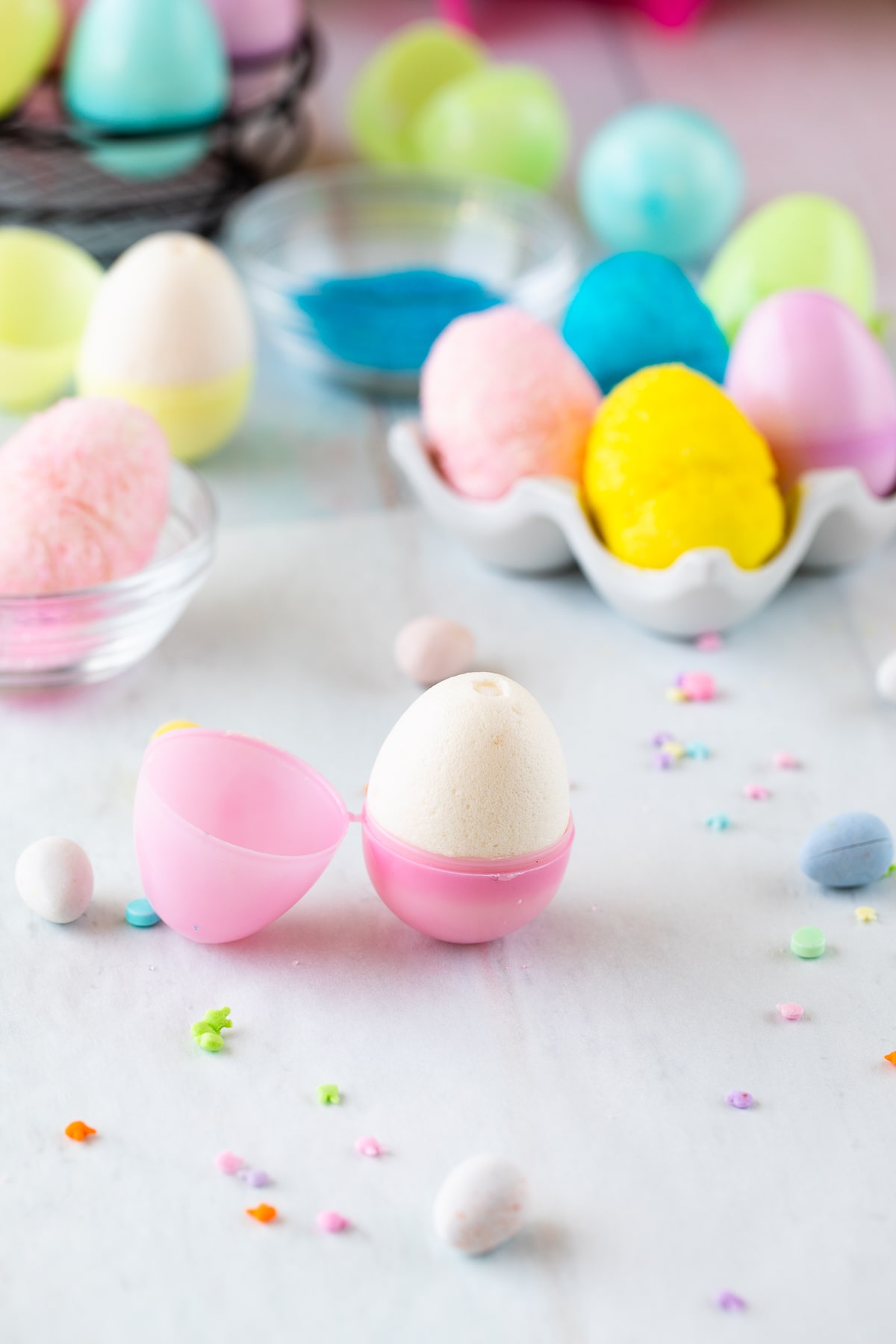
Aren’t these marshmallow Easter eggs so cute?! When most people think of marshmallows, they think of the store bought bags of marshmallows that you use for s’mores or hot cocoa, but homemade marshmallows are so much better than the super sweet marshmallows you get in the grocery store.
Plus, like these champagne marshmallows or this marshmallow frosting, they’re way easier to make than you might think! And this Easter egg version is just the cutest and the perfect addition to your holiday Easter basket.
INGREDIENTS
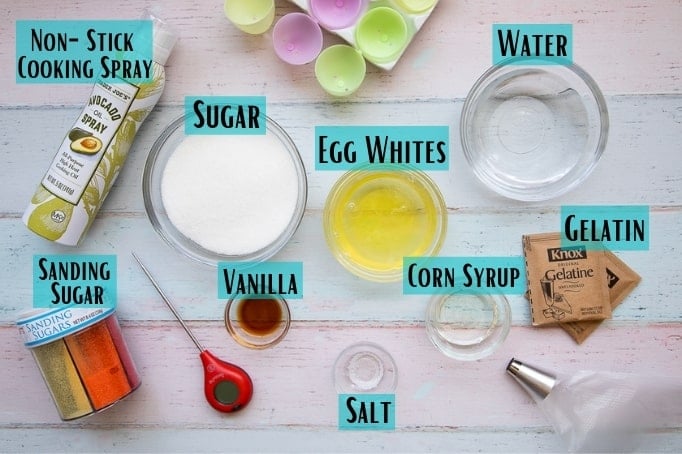
- Gelatin: this is what gives the marshmallows it’s signature marshmallow texture.
- Egg Whites: this helps keep the marshmallows light and fluffy, plus it helps for piping marshmallows.
- Vanilla Extract: you can use other extracts too! Lemon, coconut, raspberry, almond, etc. for different flavored marshmallows.
- Sugar: White granulated sugar is the way to go in this recipe.
- Corn Syrup: this is really important to keep the sugar syrup from crystalizing. You can omit it but you have to be very careful the sugar doesn’t crystalize. See the troubleshooting section for tips on how to prevent crystallization.
- Non-Stick Cooking Spray: to spray the egg shells or molds so the marshmallow does not stick.
- Sanding Sugar or Sprinkles: This is optional, but makes these so fun!
Tools
- Candy Thermometer: you do need a candy thermometer to heat the sugar syrup to the right temperate.
- Plastic Easter Eggs: You can also use silicone egg molds like these.
- Pastry Bag and Large Piping Tip: to pipe the marshmallows. You can also use a disposable pastry bag with the tip cut off.
- Pastry Brush: to make sure there are no undissolved sugar crystals when making the sugar syrup. You can also add the lid to the pot and let it steam for a minute or two instead of cleaning the sides of the bowl.
- Standing or Hand Held Mixer: a standing mixer makes this recipe much easier, but you can use a hand held mixer with a large bowl.
- Egg Carton: optional, but an old egg carton is a great way to hold the eggs while they rest.
How to Make
Prep
Spray the plastic Easter eggs with non-stick cooking spray and fit a pastry bag with a large tip and set aside. I like to put my pastry bag into a large cup or container so it’s easy to fill with the marshmallow mixture.
Blooming and Dissolving Gelatin
The first step is to bloom and heat up the gelatin. You sprinkle it over the water and let it bloom for a minute. After it has bloomed and starts to gel up, turn on the heat and cook over medium low to dissolve the gelatin. Do not let the gelatin mixture boil. Once it’s dissolved, turn the heat down to low and let sit over the warm burner while you work through the next steps.
Heating Sugar Mixture
This is the most complicated part of the recipe, and it’s not actually that complicated at all! Similar to candied strawberries, champagne marshmallows, or a croquembouche you’ll be making a hot sugar syrup. You do need a candy thermometer to determine when the sugar syrup gets to the correct temperature.
Add the sugar, corn syrup, and ½ cup water in a pot and mix over medium heat until the sugar dissolves. Once the sugar dissolves turn up the heat to medium high and cook until it hits 281-284℉, making sure to not mix the syrup at all while it cooks. This will take about 10 -15 minutes, so while it heats up, start on the next step of whipping the egg whites.
Note: at some point while it cooks, take a pastry brush dipped in water and brush down the sides of the pot to ensure there are no undissolved sugar crystals as undissolved sugar will make the marshmallows grainy.
Once it hits 281-284℉ remove from heat and immediately start pouring into the whipped egg whites. Do not let the sugar mix get hotter than the 284 ℉.
Whipping Egg Whites
While the sugar mixture is heating up, whip up the egg whites to stiff peaks. If the egg whites get to stiff peaks before the sugar syrup is the right temperature, continue to mix on the lowest setting until the sugar syrup is the right temperature.
Mixing Marshmallows
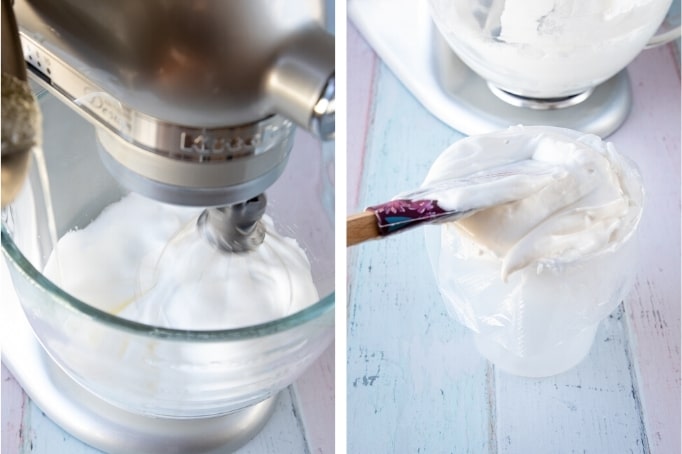
After you’ve added the syrup, immediately add the warm gelatin mix, then add the vanilla and salt. Turn up the speed to medium and whip until the marshmallow mixture cools down, about 5 minutes.
Once the mixture has cooled and turned to a thick and glossy marshmallow, quickly add to the prepared pastry bag.
Filling Marshmallow Easter Eggs
Now the fun part, filling the Easter eggs. Working quickly, fill each side of the plastic eggs with marshmallow and close together. Some of the marshmallow mixture will squeeze out of the eggs. This is fine! It means the eggs are completely filled. You want to make sure there are no air bubbles and the eggs are full of marshmallow mixture.
It helps to fill a few at a time so the marshmallow doesn’t have time to set. Once they’ve been filled, clean off the eggs of extra marshmallow mix and let sit at room temperature for at least 12 hours.
Once the marshmallows have set, remove from the shells and you can roll in sanding sugar or sprinkles, and enjoy!
Troubleshooting
My Egg Whites Are Not Whipping Up
Make sure there is no trace of any oil, fat, or egg yolks in the egg whites or on the bowl. This will cause the egg whites to not whip up.
My Marshmallow mix is Grainy
This is because at some point in the process the sugar syrup seized up. The addition of corn syrup helps combat this but there are two main reasons this happens:
- Undissolved sugar crystals in the sugar syrup
- The mixture was stirred while boiling
You combat this by making sure to not stir the mixture at all while it is boiling and also washing down the sides of the pan with a pastry brush dipped in water to ensure every sugary crystal is dissolved.
You can also put the lid on the pan for a minute or two and the steam with help dissolve the sugar crystals.
The sugar syrup hardens when poured into the egg whites
This is because it was heated up past 284℉. Try to not to overheat the mixture.
My Egg Whites are at stiff peaks before the sugar syrup is the right temperature
No problem! Just keep mixing the egg whites on the lowest setting until the syrup is the right temperature.
Can I add food coloring?
Yes! I personally prefer gel food coloring for vibrant colors. Mix it in at the final stage with the vanilla and salt.
My Marshmallows are sticking to the egg shells
Make sure to spray the shells well with non-stick cooking spray. If any part is not covered the marshmallow Easter eggs can stick. It can help to take a paper towel and lightly rub it inside the shells to spread it around.
Want More Easter Recipes? Check These Out!
- Easter Croquembouche Basket
- Easter Macarons
- Chocolate Covered Strawberries
- White Chocolate Drip Cake
- Strawberry Mimosas
WANT TO JOIN THE PARTY? Subscribe to my newsletter and follow on Tik Tok, Pinterest, Instagram, and Facebook for all the latest recipes!
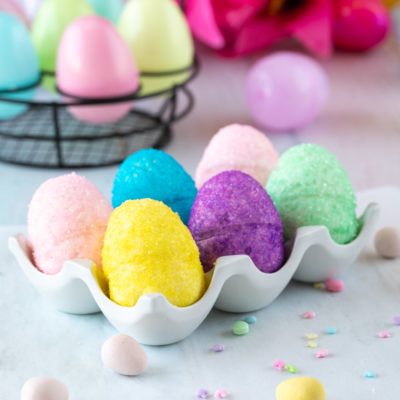
Marshmallow Easter Eggs
Equipment
- Plastic Easter Eggs or Molds
- Standing or Hand Held Mixer
- Pastry Bag with Large Piping Tip
- Pastry Brush, optional
- Old Egg Carton, optional
- Stovetop and Saucepans
INGREDIENTS
- 2 packets gelatin
- 87 grams egg whites from 2-3 eggs
- 1 tsp vanilla or 1/2 vanilla bean
- 1 cup sugar
- 3/4 cup water divided into 1/2 cup and 1/4 cup
- 2 tbsp light corn syrup
- non-stick cooking spray
- sanding sugar or sprinkles optional
Instructions
- Wash and dry your plastic easter eggs and fit a large pastry bag with a large round tip
- Spray the inside of the easter egg shells with non-stick cooking spray. Set Aside.
- Add gelatin to 1/4 cup cold water and let bloom one minute. Once bloomed put the pan on medium heat and cook until the gelatin is dissolved, stirring the mixture while it cooks so it doesn’t get a film on top. Once it’s completely dissolved reduce the head to keep it warm while you complete steps 3-6.
- Fit your standing mixture with a whisk attachment. Add the egg whites to the bowl and vanilla bean if using. Do not start whisking the whites at this time.
- Stir granulated sugar, 1/2 cup water, and corn syrup in a heavy bottomed saucepan. Wipe down the sites of the pan with a pastry dish dipped in water. This will help ensure the sugar mixture doesn’t crystallize. Turn the mixture onto medium high heat. Once it’s dissolved, simmer until the syrup mixture reaches 250 degree. This should take between 5-10 minutes.
- Let the syrup continue to cook untouched until it reaches 281 - 284 degrees. It’s important not to stir the sugar mixture while it cooks.
- While it’s cooking, start whisking the egg whites on medium high until stiff peaks are formed. You want to have the syrup at 281 degrees and the egg whites at stiff peaks at the same time. If the eggs white get stiff peaks before the sugar mixture is done, turn the standing mixture to low and continue slowing beating until the sugar mixture is at the correct temperature.
- Once the syrup is 281 degrees, remove it from the heat and slowly pour it down the sides of the bowl of egg white. It helps if the mixture is on slow to lessen splattering.
- Add the warm gelatin, vanilla, and salt to the egg whites. Once it’s combined turn onto medium high speed. Mix until it is thick and glossy, it will take about 5 minutes and should still be warm.
- Fill the pastry bag with the marshmallow mix.
- Fill one half of the easter egg with the marshmallow batter, making sure to fill slowly so there are no air pockets. Pay close attention to the bottom and top of the eggs, even though they seem full it’s very easy to get air pockets. You’ll want to start with the top of the pastry bag close to the bottom and fill upward. Then, fill the second half in the same manner and then close the egg fitting it security together. The marshmallow mixture will come out of any holes in the eggs. This is good and what you want, it means the eggs is full of marshmallow. It helps to have a wet towel near you when you fill them. That way, you can wipe each egg of marshmallow overflow after you close it. Once filled and wiped of any access marshmallow, place in the egg carton.
- Repeat with the remaining eggs. Once they’re all filled let them sit at room temperature at least 12 hours.
- Once they are ready to be served, remove the plastic shells and roll in sanding sugar or sprinkles of choice!
Notes
- Make sure the bowl for egg whites is completely clean of any oil or egg yolks. Any type of fat in the egg whites will cause the egg whites to not whip up and stay flat.
- Do not stir the boiling sugar syrup mix or it will cause the marshmallows to get grainy.
- Make sure every last sugar crystal has dissolved before adding the sugar syrup to the egg whites. See troubleshooting section for tips.
- Putting the pastry bag in a large cup or container makes its easy to fill with marshmallow mixture.
- You can make colored marshmallow eggs by adding gel fool coloring when you add vanilla and salt.
- Recipe adapted from Thomas Keller's Bouchon Bakery
- This recipe makes 12-16 marshmallow eggs.
- These will last 5-7 days in an airtight container at room temperature
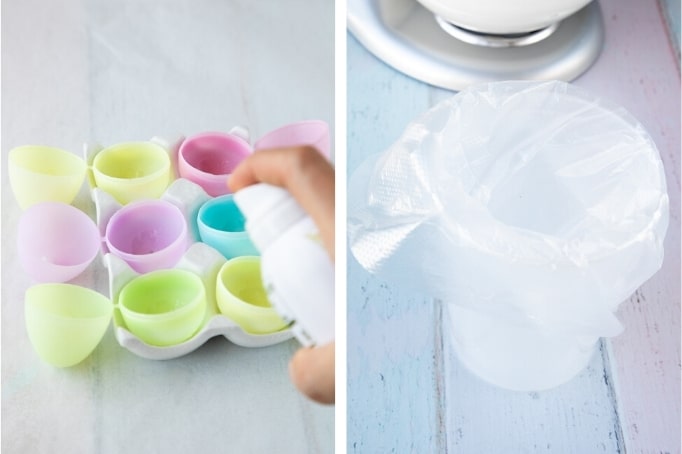
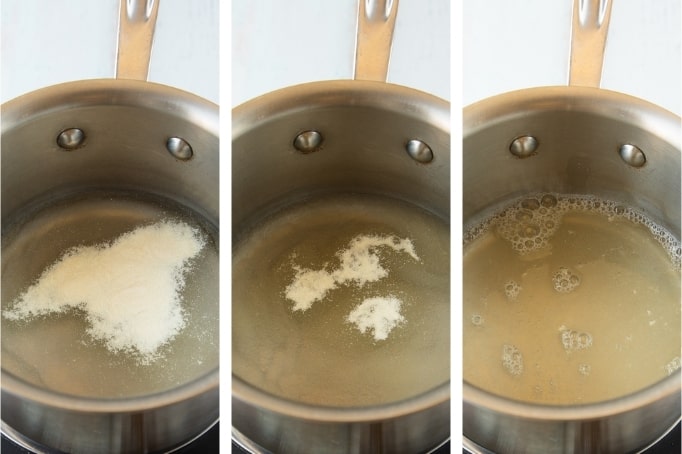
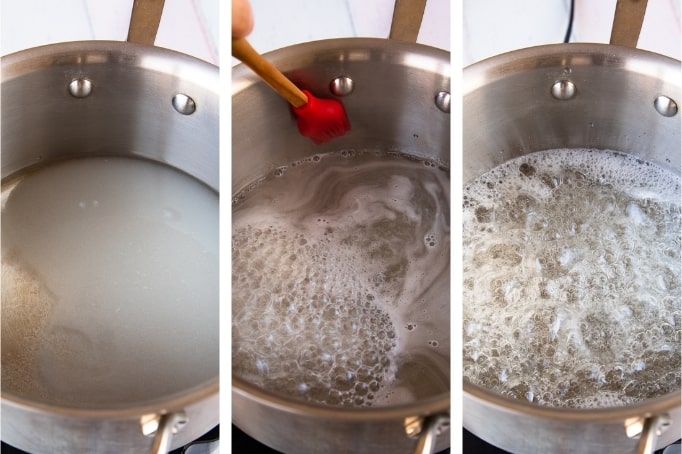
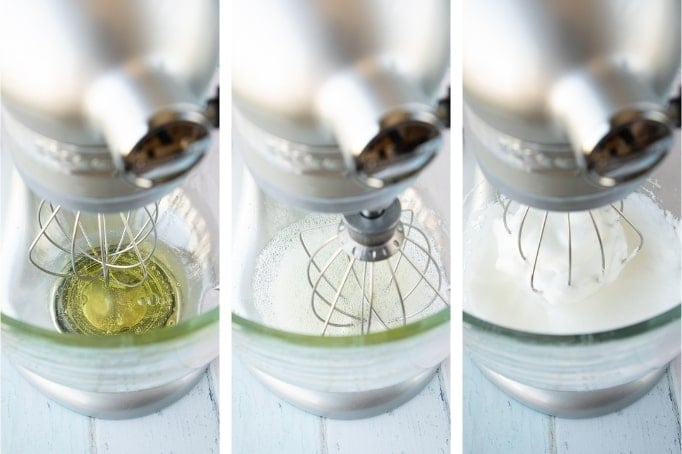
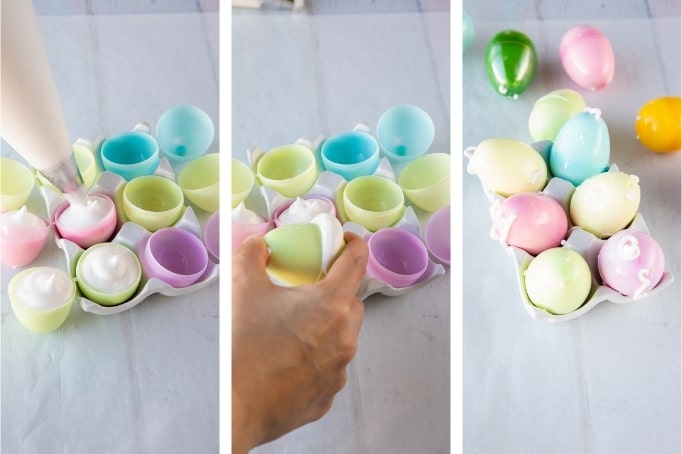
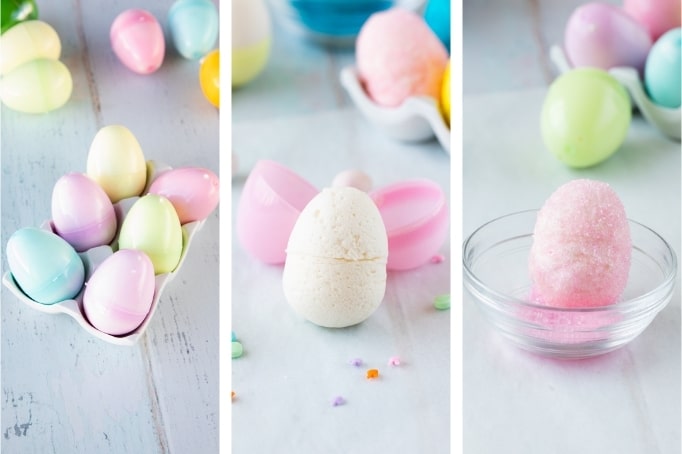
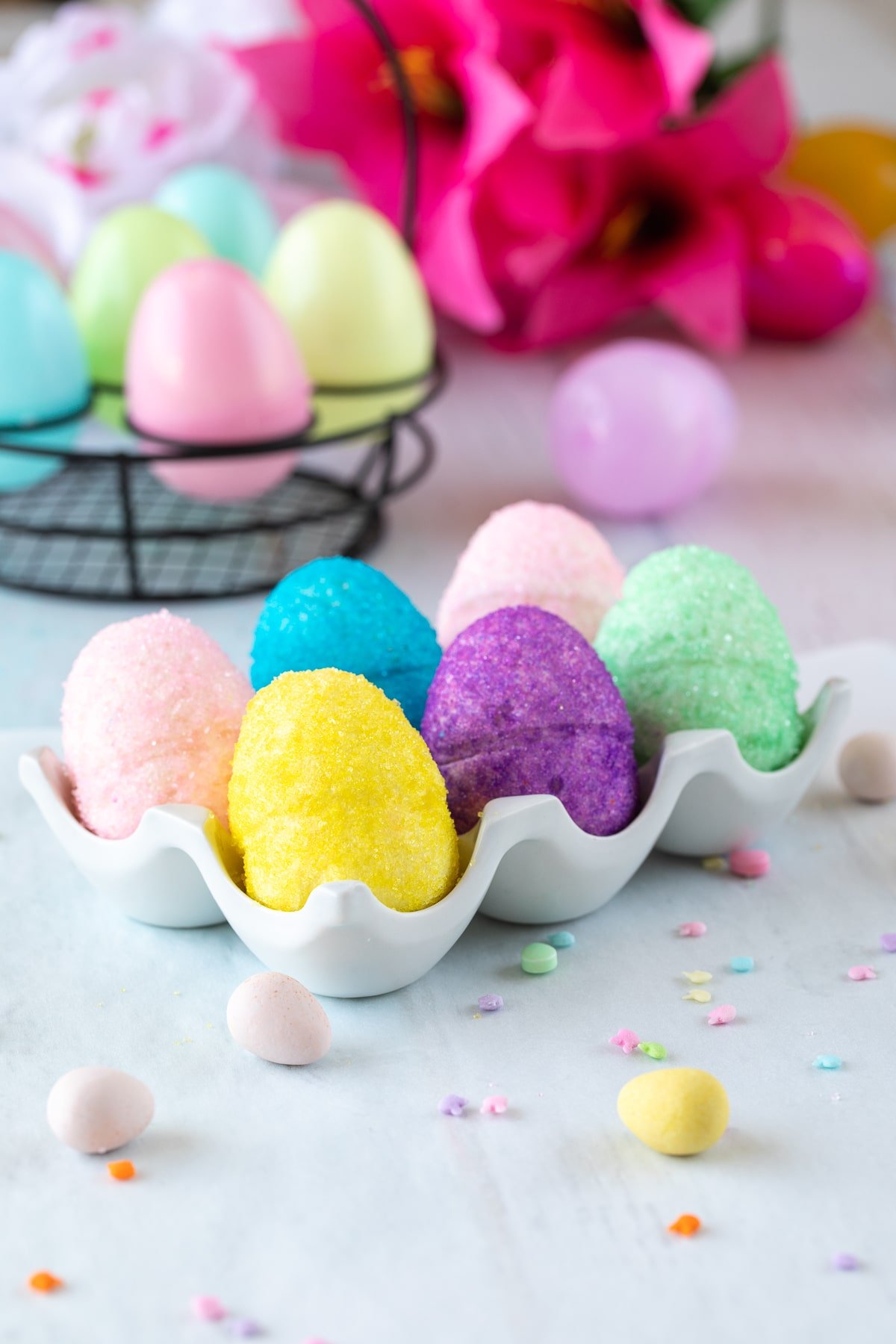

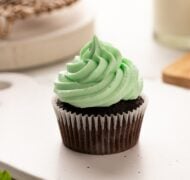
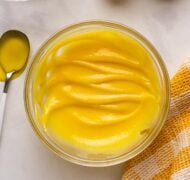
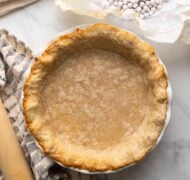
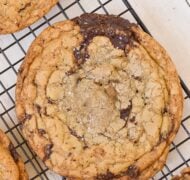
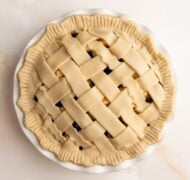

Leave a Reply